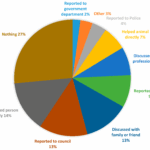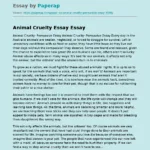Animal cruelty, a blight on the fabric of our society, extends its tendrils into countless lives each year, often unnoticed by the wider population. To comprehend the enormity of this issue, we must delve into the staggering statistics and narratives that underpin the cruel realities faced by countless animals. By gripping onto emotional threads and unraveling the tapestry of abuse, we can grasp the scale of animal suffering and the urgent need for intervention.
Every year, millions of animals experience classification under the desolate umbrella of cruelty — a term that encompasses neglect, emotional distress, physical abuse, and exploitation. Though quantifying suffering is inherently challenging, various organizations have made diligent attempts to paint a picture of this epidemic. From domestic pets relinquished in shelters to farm animals subjected to inhumane conditions, the statistics reveal a heart-wrenching saga of indifference and malice.
To begin with, consider the boundless number of domestic animals that find themselves ensnared in abusive environments. The American Society for the Prevention of Cruelty to Animals (ASPCA) indicates that approximately 1 million animals are abused annually in the United States alone. Such a figure may seem abstract, floating in the ether of online statistics, but when put into context, it translates to a vast multitude of displaced souls — each with unique identities and emotional lives. This epidemic, reminiscent of a sprawling fire that consumes everything in its path, threatens to turn loving homes into sterile environments devoid of empathy.
Furthermore, the cruel legacy extends beyond the confines of our homes. Industrial animal agriculture, a veritable coliseum of suffering, subjects billions of animals to brutal confinement, degrading conditions, and a lack of basic necessities. According to estimates, around 9 billion farm animals are raised and slaughtered in the United States every year. These creatures, often seen as mere commodities rather than sentient beings, endure a systemic cycle of abuse that is as relentless as it is tragic. They languish in overcrowded pens, deprived of the opportunity to engage in natural behaviors, only to meet a premature end that is characterized by inhumane methods of slaughter.
And it is not merely the quantitative figures that elicit concern; the qualitative aspects of animal cruelty provide deeper insights into the traumatic experiences of these living beings. The clandestine world of puppy mills starkly illustrates this point. Here, female dogs are frequently overbred, crammed into horrendous living conditions, and denied adequate veterinary care. The resulting saga of suffering can yield heartbreaking consequences: high rates of neonatal mortality, chronic health issues, and even profound psychological trauma. Every statistic represents not just a number, but a life steeped in pain — a haunting reminder that cruelty lurks at the periphery of our societal norms.
Moreover, wildlife is altogether not spared from the harrowing effects of human actions. The global wildlife crisis unfolds its awfully intricate layers as poaching, habitat destruction, and climate change exert unyielding pressure on numerous species. Although exact figures are elusive due to the clandestine nature of such activities, estimates suggest that tens of millions of wild animals are subject to cruelty each year through illegal hunting and trafficking. The sharp decline in populations of animals, like elephants and rhinoceroses, metamorphoses into a dire paradigm where extinction looms, interwoven with the threads of human avarice.
Amidst this complex lattice of suffering, the despondency of animal cruelty evokes a multitude of responses — from outrage to despair. Yet, within this landscape of adversity lies the germ of hope. Advocacy organizations work tirelessly to unravel these threads of cruelty, employing educational platforms, legal frameworks, and legislative reforms to combat the rampant abuse encroaching upon the lives of these vulnerable creatures. By elevating public awareness and galvanizing community action, we have the opportunity to effect meaningful change in the lives of countless animals.
The most profound truth emerges when we recognize that the narrative of animal cruelty is not solely about numbers or statistics — it is fundamentally about compassion, empathy, and action. Every living being has a right to be treated with dignity and respect, and when society collectively prioritizes the welfare of animals, we create a ripple effect of positivity that benefits everyone. Like the intricate dance of interdependence that defines ecosystems, our well-being is intricately linked to the health of animals around us.
Thus, as we grapple with the grim realities of animal cruelty and the staggering figures associated with it, let us anchor our thoughts in the power of collective action. The silent cries of the abused and neglected can no longer be ignored. It is imperative that we foster a culture of compassion, stepping beyond mere indifference to take concrete steps toward healing. Perhaps the first stride is to educate ourselves about these issues, understanding that awareness lays the foundation for advocacy.
To encapsulate this discussion, animal cruelty embodies a pervasive and heartbreaking reality, an emotional wound in the fabric of society that requires our urgent attention. The statistics may illustrate the magnitude of the problem, but they eventually lead us to a singular and profound question: how many lives must endure suffering before we act decisively? The call to arms is clear; the path towards a compassionate society necessitates a commitment to safeguarding the voiceless and relentless advocacy for those subjected to cruelty. Only then can we illuminate a new paradigm of respect, harmony, and understanding for all living beings.








